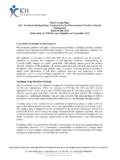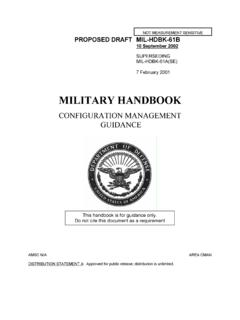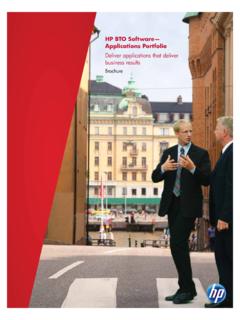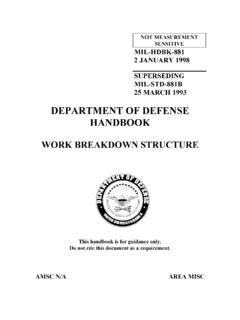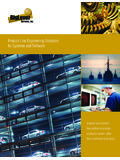Transcription of HP Application Lifecycle Management best …
1 HP Application Lifecycle Management best practices series for ALM practitioners Entities sharing best practices Technical white paper Table of contents Welcome to this guide .. 2 About entities sharing .. 2 Audience .. 3 Prerequisites .. 3 Introduction to entities sharing .. 4 Importance of entities sharing .. 4 Common entities sharing scenarios .. 5 5 IT initiatives .. 6 Enterprise release .. 7 Parallel development .. 7 Preparing for entities sharing .. 8 Definition of a project .. 8 Application .. 8 Version/model.
2 8 (Custom) Project .. 8 LOB .. 8 Repository .. 8 Everything .. 9 Library types .. 9 Compliance library type .. 9 Integration library type .. 10 Entities library type .. 11 Defining a library .. 11 Importing and synchronizing a library .. 12 Import status .. 13 Making entities sharing work .. 14 Roles and responsibilities .. 14 Development scenarios .. 15 Sequential development .. 15 Parallel development .. 16 Connection to source code control .. 18 Reconciliation tasks .. 18 Conclusions .. 19 2 Welcome to this guide Welcome to the HP entities sharing best practices guide for HP Application Lifecycle Management (ALM) software.
3 This guide provides insights into concepts, guidelines, and practical examples for the best implementation of entities sharing such as requirements, tests, test assets, and business components in various organizations. About entities sharing Traditionally, the Application quality Management market has been focused on specific testing activities, such as load/stress and functional/regression testing. As the market shifts, organizations are seeking a combination of greater business value and agility. Businesses are therefore required to take a more holistic and agile approach if they hope to attain better quality.
4 To meet their business objectives, they need to evolve from simply finding defects to also validating functionality. Such an approach is driven by the need for companies as a whole (not just their IT divisions), to increase efficiency and productivity so that they can maintain market leadership and attain a competitive advantage. The organizations of today must validate and manage: Business functions: Raise user-acceptance level and decrease testing costs while providing increased requirements coverage. Production readiness: How does the Application scale?
5 Is it secure? Risk status: Increase regulation (for example, data privacy and compliance) and security requirements while managing costs. To manage the process, organizations need to focus on overall governance rather than specific tasks. In addition, an increase in the complexity of modern systems, composite applications , and service-oriented architecture (SOA), as well as the growing number of regulations requires more effective solutions to satisfy quality levels. HP ALM addresses these needs in a comprehensive manner.
6 It facilitates all types of Application tasks, using a solid foundation for managing complex initiatives and regulatory requirements. HP ALM is designed to address the needs of organizations that are looking to track and manage projects of all sizes, including large initiatives and enterprise-wide releases. HP ALM can help facilitate a center of excellence (CoE) approach a logical or physical entity that drives standardization and processes across an organization, to improve quality, consistency, effectiveness, and efficiency.
7 The purpose of this document is to assist HP ALM customers in assessing their current software development Lifecycle (SDLC) practices and successfully build and maintain a quality methodology using advanced features provided by HP ALM. All aspects of this process have been researched using best practice data and expertise from various sources such as HP operating system administrators, HP Professional Services, technical documentation, books from industry experts, and the personal experience of many customer quality organizations.
8 These guidelines help reduce in initial creation time and achieve improved value in operating the HP ALM. 3 Audience This guide is intended for: Business analysts Quality CoE managers Quality automation engineers Development managers Prerequisites To use this book, you should have a good acquaintance with major phases of the SDLC. You should also be familiar with the business processes in actual IT organizations. Operational knowledge and administrative privileges of HP ALM are essential in implementing these best practices .
9 It is strongly recommended to read the Libraries and Baselines and imported libraries chapters of the HP Application Lifecycle Management user guide to get a general understanding of libraries, baselines, import, and synchronization features mentioned in this document. Note: All features discussed in this document are available only in HP ALM version These features are disabled in HP Quality Center Starter Edition and HP Quality Center Enterprise Edition. 4 Introduction to entities sharing Importance of entities sharing In the world of cross-functional IT initiatives, the same Application may be incorporated into multiple initiatives.
10 It is critical for various IT teams to be able to share the same set of requirements, tests, test assets, and business components in order to validate that the new initiative is working as expected and does not disrupt the behavior of other applications . Instead of re-creating entities, customers should be able to share the same entities across projects. Since many industries are heavily regulated and must pass a variety of compliance-based tests such as Sarbanes-Oxley (SOX) and HIPAA, it would be highly inefficient to duplicate entities across multiple projects especially when these regulations are updated regularly.


